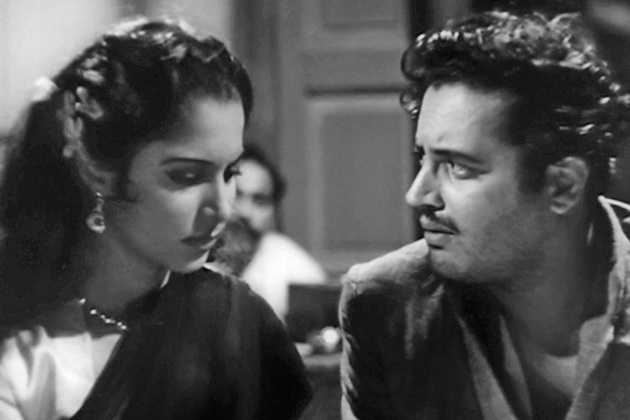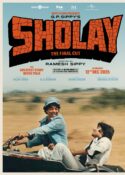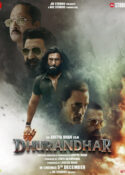There was a time when I was a teenager that I would watch Guru Dutt’s masterpiece Pyaasa every afternoon. Each time, something new was found in the narrative that was rich with detail and poetry that is right up there with my favourite film ever made, Citizen Kane. The similarities between Orson Welles and Guru Dutt are tantamount. They were both fiercely original and daring filmmakers who had changed cinematic storytelling and mise-en-scene forever. They had their demons of wine and women, but they were tortured artists afflicted by demons that bleed into some of their cinematic gems.

From the opening song ‘Yeh Hanste Hue Phool’ that is beautifully picturized against a bee pollinating the flowers as the poet Vijay (Guru Dutt) looks on at the serenity of this image, before a man stamps down on the bee. It tells us all we need to know about Dutt’s core themes in his films, man’s spiritual and creative quest being stifled and unappreciated by a modernizing and harsh world. Yet the film touches on much more than this, the unrequited love between the streetwalker Gulab (Waheeda Rehman, in her debut role) and Vijay, or the materialist aspirations of his former love Meena (Mala Sinha). Vijay ambles through a series of vignettes that underscore his unhappiness as his moral condition deteriorates. His poems remain unsold and offered as junk paper. He is unexpectedly reunited with Meena at a reunion where he sings ‘Tang Aa Chuke Hain’ a stinging critique of the world breaking his spirit and directed at her. Her husband Ghosh (Rehman) a publisher instinctively recognizes Vijay as a former love and hires him as a lowly clerk. Meanwhile, Vijay meets with friend Abdul (Johnny Walker) and Gulab, who falls for him and sings his poems in her pursuit. Vijay eventually strains Meena’s marriage and sadistically Ghosh refuses to publish his poems and calls on him to be a waiter at their mehfil evening and fires him in a fit of jealousy. Vijay gives his coat to a beggar, who gets run over by a train, he is mistakenly pronounced dead. Gulab realizes his dream and gets his poetry published, and it becomes a big hit. Those who scorned Vijay try to cash in on his fame, and he comes back to a public memorial to denounce the hypocrisy of a world that crushes an artist’s soul and freedom in the sweepingly beautiful ‘Yeh Duniya Agar Mil Bhi Jaaye.’
The film is a perfect meeting of style and theme, aided by V.K. Murthy’s stunning cinematography and Sahir Ludhianvi’s stirring lyrics. Dutt was a consummate innovator, in making the film song integral to the narrative. One scene where Vijay runs into Meena in a lift is particularly wonderful, V.K. Murthy’s stunning camerawork where Meena’s smiling face is reflected into the wall, and dissolves into a flashback of their courtship. The film is a classic because of its revolutionary mastering of filmic techniques. The iconic song ‘Jaane Woh Kaise’ is filmed with utmost dexterity with its tracking shots that emphasize the unbridgeable distance between Meena and Vijay’s paths, while zooming from Meena towards Vijay to signify her dormant feelings for him. With meandering camera that has that magnetic push and pull between the principle players, the songs are symbolic and redefined the art of the film song. The picturisation of these scenes highlight a master at work, adeptly converging elegiac lyrics, lilting music, to the fluid cinematography and crisp editing to achieve the ultimate mise-en-scene that makes you gasp at Dutt’s pioneering.

Pyaasa is a sombre and dark film that does not hesitate to point fingers and resent a world that sullies a poet’s creativity and soul in its pettiness and hypocrisy. Vijay’s trials mirror that of the nation, which was coming from the Partition and a rapid urbanization and industrialization in the cities. The allegorical value of the film came at a time during that Golden Age where directors had the freedom and gumption to address the failings of the new nation to establish itself as one that reflected the egalitarian ideals. Dutt’s nihilistic view of the world is a much bleaker than that of Raj Kapoor’s Raju the Tramp vehicles or Dev Anand’s Navketan noirs, the city, and its inhabitants are the persecuting force that fail to understand or nurture the genuine soul. Pyaasa remains one of the most blistering critiques of the eternal struggle for identity in a chaotic unfeeling world that made it a hit at the time and an enduring classic for film buffs.
Pyaasa marks the peak of Dutt’s career working with fabulous collaborators like screenwriter Abrar Alvi, poet Sahir Ludhianvi, comedian Johnny Walker, and his muse Waheeda Rehman. He was a true auteur whose signature stamp you can recognize from the iconic imagery and powerful symbolism. There are so many moments etched into my memory whenever I recall this film that it retains that fiery spirit even 56 years later. The performance are simply perfection, Dutt is a complete triple threat, a great actor/writer/director much like Welles to not let any of his assigned roles get the better of him. He conveys years of anguish and pain into a simple sigh or expression, which is a testament to his genius. Mala Sinha gets the tough role of Meena, and underplays her role wonderfully in not turning her into a hateful figure. Sinha looks simply resplendent in the loving close-ups that she is given during the initial scenes. And the movie would not be the same without Waheeda Rehman’s serene portrayal as Gulab. You can tell why Dutt found her to be his muse; she is simply effortless in her role, at times spritely and melancholic in her love for Vijay.

Pyaasa has a poetic realism that elevates its scenes of despair and sadness, as we cannot forget like Vijay when the courtesan cries mid-dance as her ill baby cries outside or Waheeda Rehman’s rapturous longing during ‘Aaj Sajan Mohe Ang Lage’ that reverses the gaze of the desired. The film is rife with brilliant symbolism that makes an artistic triumph that bridges the visual and aural elements with such finesse. The final song, ‘Yeh Duniya Agar Mil Bhi Jaaye’, is the textbook example of this Dutt style, as the song plunges into a dramatic and musical crescendo that culminates in the reverent shot of Vijay in a crucifixion pose. As Vijay is ‘resurrected’ for the public, the crucial lyrics are intercut with reaction shots of key players that have betrayed him or uphold his memory. Murthy’s camera uses a tracking shot upwards from Vijay’s pose to magnify his poetic stature as the one true man in this world. Dutt sets the perfect pitch for the denouement where the scathing verses grow and music swells, to Mohammad Rafi’s voice breaking to shout “Jala do isey, phoonk dalo yeh duniya” as the crowd drags him away. It’s simply the best culmination of a song to evoke the denouement in such frenetic and striking staging.
Pyaasa is one of my favourite films of all time, and naturally its brilliance and style earned it a spot on Time Magazine’s Top 100 Films List. Few geniuses make films that stand the test of time and technology, but Pyaasa is endlessly brilliant and innovative with elements that take you by surprise on the 1000th watch. It’s brutal frankness and visual style was revelatory at the time and inspired legions of directors hoping achieve that perfect confluence of collaboration and verve.









